|
|
||||
The dismal, destitution of our national energy debateYou would think our former Chief Scientist would know how to do basic research before commenting in the national news? Alan Finkel says Australia probably couldn’t build one nuclear plant in less than twenty years, because the UAE took fifteen years. But fifty years ago the French built 56 nuclear plants in just 15 years. Isn’t that relevant and shouldn’t we at least mention that? At the time, the population of France was 51 million — twice what Australia is today. So pro rata, Australia could be aiming for 26 reactors. If we ask nicely, perhaps we could borrow the old 1973 plans? The Messmer plan was launched in response to the oil crisis and the French started construction on three plants in the same year. The slogan they used was “In France, we do not have oil, but we have ideas.” In Australia, our slogan it seems, is we don’t have oil, but we buy solar panels from China. In a similar vein, two weeks ago Sweden announced it would be building 10 new nuclear reactors by 2045. With 10 million people, the pattern apparently is that building one nuclear plant per million people is the norm. Now both those countries already have or had a few nuclear plants running, so they weren’t starting cold. Australia just has one medical grade reactor and some hypothetical nuclear subs. But in 1973, France didn’t have fifty years of industrial research to draw on, and there weren’t 436 reactors operating around the world. If hypothetically, we were in an existential crisis of world ending proportions, you’d think we could build faster than we used to in the 1970s? Alan Finkel was Special Adviser to the Australian Government for Low Emissions Technologies for two years up to November 2022, so he was paid to know this sort of thing. Nuclear power is the ultimate low emission technology. It was his duty to figure this out. Last year he was awarded the Companion of the Order of Australia (AC) in the Australia Day Honours for “eminent service to science, to national energy innovation and research infrastructure capability, to climate change and COVID-19 response initiatives, and to science and engineering education”. These prizes have become a bad joke. Alan Finkel clearly doesn’t mind giving Australians half the truth and the Sydney Morning Herald is of course, happy to print drivel. All Mike Foley, said journalist, had to do to be investigative was phone up anyone in the nuclear industry in the USA or France, or search on a climate skeptics blog. Coalition’s campaign for nuclear energy implausible, experts sayMike Foley Sydney Morning Herald Former chief scientist Alan Finkel says it would take decades to develop a local nuclear energy industry, as he and other experts reject the Coalition’s push to switch focus from renewables to nuclear as implausible since Australia needs urgent replacement for its ageing coal-fired power plants. Finkel said it was highly unlikely that Australia could open a nuclear power plant before the early 2040s, saying autocratic United Arab Emirates took more than 15 years to complete its first nuclear plan using established technology. Instead of being an “Order of Australia” kind of guy, serving his country, Finkel sounds like a salesman for renewable energy: The economic viability of Australia’s ageing fleet of coal-fired power stations, which still make up two-thirds of the electricity grid, has been hammered by cheaper sources of renewable energy. Replacement power is urgently needed, with five of 15 plants due to shut within a decade and more tipped to follow. The whole system cost is ultimately what matters to families. We keep adding renewable energy and yet the more we add the more the prices rise. That’s the evidence that matters, the observation a “scientist” is supposed to notice. In the end, Australia needs cheap energy and nothing is cheaper than coal. Burn the coal, feed the world, and then set up a nuclear industry…
h/t indefatigable David from Cooyal in Oz Wikimedia photo compiled from photos by Utilisateur:Djampa, Andrzej Otrębski, Panelfestoon, Esby, Soviflo, Sancio83, Florian Pépellin, François GOGLINS, Xtrasystole, Stefan Kühn, Raimond Spekking, SashiRolls, Pablo el ciclista, Serlito, Yelkrokoyade, Felix König.
Suddenly Australia needs $1.5 Trillion dollars on Energy “Moonshot” quest for global weather controlNow they tell us:…big spending on renewables needed, says reportAustralia must find $1.5 trillion by the end of the decade to meet 2050 green targets in an effort experts say would need to mirror the reconstruction of Europe after World War II. — By Nick Evans, The Australian Until five minutes ago (or at least the last election), wind and solar power were the future — they were unstoppable because free energy paid for itself and was getting cheaper every year. (Cheaper than free!) Now, we’re out of the mists of the fairy garden, a few passengers on the top floor of the Carbon Bus can see the cliff coming. Suddenly we’ve gone from “it’ll save money” to needing $1,500 billion dollars or 1.5 million suitcases of a million dollars each, which is quite a lot in a land of 26 million people. It works out to be $57,000 each from every man, woman, pensioner and baby, and we need it in the next 7 years. So that’s a quarter of a million dollars from every family of four. Nevermind about a house or a holiday, if we’re serious, we need to work weekends, and send the kids to the factory after school. What’s the award wage for ten year olds? We’re going to do “a Moonshot” apparently. Shame no one mentioned that at the last election?The new report came out last month from the expert committee we’d never heard of — Net Zero Australia. The largest economic transformation in Australian history is among the final conclusions of the major expert study of Australia’s path to net zero carbon emissions, conducted by interdisciplinary teams from the University of Melbourne, The University of Queensland, Princeton University’s Andlinger Centre for Energy and Environment, and Nous Group. Australia just needs to build 230 GW of renewable energy generation by 2035, and at the moment we’ve got 50GW “committed”: The report says that nearly 50 gigawatts of planned and committed renewable energy generation falls well short of the 230GW estimated to be needed by 2035, and that a drastic acceleration of both onshore and offshore wind developments would be needed to provide future power. Robin Batterham – emeritus professor of engineering at the University of Melbourne and Australia’s former chief scientist – who chaired the group’s steering committee, said it was a huge task. Just like that we will train up 100,000 engineers and tradesmen in the next 7 years: The economic push would be enormous, even among the working population. Net Zero Australia’s modelling suggests the skilled workforce needed to install and run new generation assets, transmission lines, and associated decarbonisation efforts will need to double to at least 200,000 people by 2030 and reach 700,000-850,000 by 2060 – up to 4 per cent of Australia’s estimated total workforce. The experts in the new committee dared to suggest we need to build a new fleet of gas plants, and keep the old coal generators running until we have new reliable supply available. They can see how a few billion-dollar blackouts will dent enthusiasm for the green renewable racket. Improbably, they say that we must keep all the options open, except for nuclear, of course, and that crazy idea of auditing the pronouncements of a foreign committee. We shouldn’t wait for “silver bullet” technology like small modular reactors, they say, but it’s OK to wait for cheap batteries, reliable wind plants, safe disposal of turbine blades, dead eagles, beached whales, and reports on infrasound pollution from studies no one has done yet. Don’t mention the risk reward ratio…We need to spend $5 Trillion by 2050, build 40 times the generation, and based on dubious economic modeling with twenty-five years of extrapolated guesses about technologies that are not invented yet, we might reduce energy costs from 9% to 7% of the total economy, but we will definitely cool the world by no degrees? Renewable energy generation would need to grow to about 40 times the current NEM generation capacity, according to previous modelling by the group – but, even under the most aggressive renewable energy scenario modelled by Net Zero Australia, the country’s total domestic energy costs would fall from just under 9 per cent of GDP to about 7 per cent by 2050. Australians have gone gangbusters installing wind and solar in the last ten years but we need to do “40 times as much”. Plot the curve to 2050 in your head: No one is taking the transition, or carbon emissions seriously. As long as the gravy flows… — AI generated art by Jo
By Jo Nova The war on the poor has become a war on surveillance camerasThe ULEZ “Ultra Low Emission Scheme” in London will force drivers in outer London to pay a draconian £12.50 daily ULEZ fee when the scheme expands to their area from August 29th. But many of these people are poor and can’t afford to buy a new car or pay the fee. People who own diesel cars older than 2015 or petrol cars older than 2006 will have to pay the fees, so this will hurt the poorest people the most. Not surprisingly, this is very unpopular, as it has a large impact on some people’s lives. Tradies are wondering if they should give up their business, and older people are already being forced to sell their cars. Healthcare workers on late night shifts may end up trying to get home to outer suburbs in the dead of night on sparse bus routes. Everyone inside the ULEZ zone will also end up paying more to get tradies from outside the zone to come into it. This affects a lot of people, and perhaps as many as 850,000 vehicles registered in London are not compliant. The RAC says that “it will have a massive financial impact on motorists and businesses”. Neil Garratt AM points out that while Sadiq Khan thinks the poorest Londoners don’t own a car the TfL (Transport for London) data shows that most do own a car, and they are more likely to own a car than the very highest income houses in inner London. (See the graph below). Not surprisingly, people are angryOfficially some 339 reports have been received of damaged or missing ULEZ cameras — but an unofficial map tally suggests the number is more like 460 or 28% of all the cameras installed so far. If only there were a better way to solve this, like say with a referendum? Let’s give people a vote instead. Perhaps they won’t want to give up their cars to make the world 0.000 degrees cooler in one hundred years time? These rules are so invasive, people are getting desperate. Ulez: More than 300 cameras damaged or stolen in four monthsBy Yasmin Rufo, BBC Over four months, the Met received 339 reports of camera cables being damaged, or cameras being stolen or obscured. The actual number of cameras affected is likely to be even higher as one report can represent multiple cameras. Unofficial data mapping the location of disabled cameras suggests that almost 500 cameras could have been affected. The force has not revealed the locations of any of the disabled cameras but a group of people calling themselves Julie’s Ulez map, who are opposed to the Ulez expansion, worked to track the locations and damage caused to cameras. The map shows there are 1,619 cameras outside the North and South circular roads with 461 of those reported as vandalised or stolen – equating to 28% of the Transport for London’s (TfL) network cameras. In the graph below “no car” is the blue line, and in Central London around 75% of the rich and poor don’t own a car. But in the outer zones only 20-40% don’t own a car, and presumably poorer people would own more cars if only they could afford it, since that’s what everyone else in their area with more money does. Click to enlarge: This graph above shows the phenomenal success of the invention of cars and the industrialization and free-market that made it possible. In a little over a century, more than half of the poorest citizens were able to buy something far better than what the richest of the rich once had. Alfieri Maserati in 1908  1908 Grand Prix des Voiturettes at Dieppe was Alfieri Maserati in his Isotta-Fraschini, |Bibliothèque nationale de France. Agence Rol. Resistance is growingGroups, apps and interactive maps are springing up to protest and to map the locations of the cameras. Some councils have refused to allow cameras on the roads they manage, but most main roads will be covered with 2,750 cameras when the full set are installed. Stop Ulez.com reports Currently two people have been charged with criminal damage but one case has now been dropped the night before a crown court appearance (congratulations Kingsley – common sense prevailed) and the other is on-going, with a not guilty plea, crown court date and a lack of evidence. The ULEZ Camera ConundrumThe ULEZ Extension will be monitored by cameras, which are going up at an alarming rate on a traffic light near you (in you live in the large expansion zone). Although some councils have refused to allow TFL and Sadiq Khan to install cameras on council property and council owned roads, TFL are allowed to install whatever they fancy on routes that they manage. They are also installing ULEZ signage, the legality of which is being disputed, as discussed here by Bexley Council. These routes cover virtually all the main roads that run through each borough. This prolificacy means that the chances of avoiding the cameras and finding a sneaky back route to the a school or allotment is severely limited. Other links:
Photo Ford Model T: ModelTMitch
Maybe the world should talk about bioweapon research?The way Robert F Kennedy Jnr describes it to Tucker Carlson, it seems Anthony Fauci was not only a “director of health”, he was also a director of bioweapons. And he was the most well paid public servant in the country, thanks to a 68% raise to his salary — which came not from the health department but from the Pentagon. It’s an odd conflict of interest. Kennedy points out that to deploy an infectious bioweapon you need a pre-prepared successful vaccine so the infectious agent doesn’t make your side sick too. He claims there are something like 36,000 scientists involved in bioweapons research or gain-of-function work in countless labs in the US and overseas. “We have no idea how many there are”. Kennedy calls it the inverse of medicine, where life scientists are really “death scientists” who make diseases more deadly. In 2014 three bugs escaped from three different labs in high profile breaks, one was smallpox. “RFK: “Anthony Fauci got all the responsibility for bio-weapons development….[After three bugs escaped] in 2014, 300 scientists wrote to President Obama and said ‘you’ve gotta shut down Anthony Fauci, because he is going to create a microbe that will cause a global pandemic.’ And so Obama signed a moratorium and shut down the 18 worst of Anthony Fauci’s experiments, where most of them were taking place in North Carolina by a scientist called Ralph Baric.. ….Instead of obeying that law, Anthony Fauci shifted lots of his operations offshore. And those operations ended up mostly in Wuhan Lab, which is a military lab….and many of them went to Ukraine.”” — Bitchute Most of this research is funded by the Department of Defence, and USAID a CIA program. This 5 minute segment above, is a part of a ten minute discussion of bioweapons from 35 – 45 minutes in the full Tucker Carlson interview. (Which is all interesting). RFK also mentions that Anthrax was made and used by the US intelligence at the time of the Iraq war. The FBI — after a year of investigation — found that the anthrax came not from the terrorists but from the CIA lab at Fort Detrick. US Bioweapons were shut down in 1969 thanks to Nixon, who went on to arrange an international agreement to stop bioweapons in 1972. But in 2001 the Patriot Act came in declaring that while they were technically still banned, bizarrely there would be no punishment for any federal official. That effectively rebooted the bioweapons arms race which had been dormant for 30 years. The last 70 years has been the safest medical era to be alive in history. It’s time we discussed the new wellspring of pandemics. That’s a lot of labs…
 Image by Pete Linforth from Pixabay The Government is not afraid of misinformation, they are afraid you will speak the TruthAdd your submission by August 20th Misinformation is easy to correct when you own a billion dollar news agency, most academics, institutions, expert committees and 25% of the economy. The really hard thing, even with all that power and money is to defend an absurd lie and stop people pointing it out. Like for example if you want to spend a trillion dollars of taxpayer money using power stations, cars and steak sandwiches to change the global weather. For that, you need the Ministry of Truth to force the falsity on the serfs. The best way to deal with misinformation is to speak better information. Let the court of public opinion decide. There is something profoundly arrogant about the assumption that 26 million brains are too stupid to figure out the truth when left to their collective free debate. The proposed Australian Communications and Media Authority (ACMA) misinformation bill is truly the draft that Mao or the Politburo would have admired. Effectively if you are government “approved” (institutional, academic or official news) you are free to say whatever you like, but if you are the untermenschen, you are not — even if you ultimately speak the truth. Digital media platforms will need to self-censor the vague and unknowable comments that may be misleading and may cause harm or they face monster fines like $6m or 5% of revenue (which for Twitter is something like $150m). The mushy, ill-defined and open nature of this is exactly the point. Which publisher will be able to afford to hire the QC lawyers and run test-trials to figure out in advance if a comment breaches the code? It’s so much easier just to take the safer option and shhh, skip those provocative thoughts. Why bureaucrats can’t be left to censor free speech under Labor’s ACMA bill proposalBy David Coleman, Opposition communications spokesman. The Australian Misinformation is defined very broadly. It is information that is “false, misleading or deceptive” and is “reasonably likely” to “cause or contribute to serious harm”. The bill then uses an extremely wide definition of harm, which includes things such as harm to the environment, harm to the economy or a section of the economy, or “disruption of public order or society in Australia”. The Government IS “the truth”: The bill is very poorly constructed and includes many obvious red flags. Under Labor’s bill, if the government says something, then it is not misinformation. Authorised content from any level of government cannot be misinformation. That same protection does not apply to non-government parties or ordinary Australians commenting on political matters. This is indefensible. Academics are exempt because there’s no need to control them with ACMA, they can be sacked, intimidated, or defunded already anyhow (see Peter Ridd): Statements made by academics are exempt, but not statements made by non-academics on exactly the same topics. So an outsider with an unfashionable view could find their contribution has been deleted as misinformation. Given the seismic contributions of unfashionable outsiders throughout history, this shows an extraordinary lack of wisdom. Statements made as part of “professional news content” are exempt, but those statements are not exempt in other contexts. So if a journalist made a comment on their personal Facebook page, or appeared on an independent podcast, their statements could be misinformation. And if a statement made in “professional news content” is repeated outside of that environment, it would not be exempt from the law. So if you thought you could quote Professor Peter Ridd on the replication crisis in science, or fabricated photos in reef research, think again. You may be harming the Spotted Left Wing Parrot fish. If a Prime Minister were to say they were “the single source of truth”, say, it could be published once in a newspaper but if the punters were to repeat it ad nauseum mockingly on social media, in strictly accurate quotes, that might become misinformation? I mean, the repetition might harm the children’s sense of civic duty, after all? I don’t know, but that’s the point of the spaghetti mess in legalese. Try reading it. You are not supposed to know. You can say anything you want from under the boot… These apply to all Australians, not just publishers!ACMA’S coercive powers under the bill are very concerning. Those powers apply not only to digital platforms but to all Australians. ACMA may pursue any person if it believes they have information about “misinformation or disinformation on a digital service” and that it requires the information to perform its functions. ACMA can force the person to appear before it to answer questions about misinformation or disinformation. Journalists in professional news organizations are exempt, but not citizen journalistsHypothetically, if any systematic corruption or intimidation (or delusional fashion) were to sweep through our main media outlets (like the idea of chopping healthy body parts off teenagers), an outsider media platform would be the one to point that out, yet they would be subject to “misinformation” codes and draconian fines. Satire is excluded, but what if the government doesn’t find it funny?Who decides what satire is? Whoever they are, they be the King of Conversations online in Australia: The bill excludes statements made in good faith for the purposes of entertainment, parody or satire. But it does not exclude statements made in good faith for the purpose of political debate. So a comedian commenting on politics would be protected from having their content removed, but a non-satirical citizen offering their honest views on political matters would not be protected. Blog Comments not allowed?If these laws came into being, would this blog have to close all comments? Would this blog even exist? The Ministry of TruthJames Hol on The Liberty Itch … many are under the mistaken assumption that this will only apply to social media giants. In fact, it will apply to every single website that provides “news content” and has an “interactive feature”. If you think you can avoid the Ministry of Truth by simply starting your own social media platform or providing content on your own website, you’d be advised to have no interest in a comments section or posting video content, otherwise that website will also be captured by these draconian laws. Indeed, this Liberty Itch masthead will be at threat of fines in the millions of dollars should this Bill become law. While the Bill gives lip service to our constitutionally implied freedom of political communication, it attempts to circumvent it by creating a fascistic partnership between ACMA and private entities. Instead of ACMA enforcing speech, it makes digital service providers do its dirty work – at threat of significant fines. However, ACMA can impose industry-wide standards and codes if digital service providers go rogue and dishonour their fascistic agreements. Hoping for a safe haven at Elon Musk’s Twitter (now called X), might be more pipe dream than reality. Would I have to register as a news outlet, set up my own university, or revert to permanent satire or salad-coded language (did you take your booster carrot today?). It appears this bill is designed to capture all the online free speech that is not already controlled by Big Government or Big Money. The new Printing Press arrived to give a voice to the People, and it must be stopped. Please send in those submissions!As David Maddison, Penguinite, MP, Andrew McRae, Konrad and others suggest: Don’t forget to put your submissions in opposing the latest proposed Australian Government censorship legislation. “New ACMA powers to combat misinformation and disinformation”. They don’t have to be long. But it closes on August 20th. Read Konrad’s submission here. The bill, the Communications Legislation Amendment (Combating Misinformation and Disinformation) Act 2023.
Any which way you look at global drought measures in the last 120 years this is not the CO2 doom scenario of the IPCC prophesies either in rainfall patterns or in water supplies. The graphs below show rainfall trends shifting slightly due to unknown forces and looking for all the world, like CO2 is irrelevant. Despite the scare campaigns about floods and droughts, and the threats of climate wars over dwindling rivers, there has been no trend in hydrological droughts since the Wright Brothers first flew a plane. Kenneth Richards at NoTricksZone reported on Shi et al, a paper which looked at trends from 1902 to 2014 in all nine climate zones of the world. The first graph shows a mixed bag of trends in Meteorological Droughts, none of which are obviously linked to human emissions of CO2. Remember, half of all human emissions since we crawled out of caves has been emitted after 1995. According to CDIAC fully 250,000 Mt of CO2 was emitted up to that year, then we have doubled that in the years since then. If CO2 was a planet transforming molecule, surely we’d see something in the last 25 years? The bottom line is that if we had climate models with any understanding of rainfall they would be able to predict wet and dry seasons, and trends in droughts, floods, streamflow, and rivers. Instead, like stone-age heathen victims, we wail and lament any time a flood or a drought happens anywhere. We blame camels or cows, trucks and planes. We change our light globes and hope our houses don’t get washed away on the same floodplains that were inundated 100 years ago. The first graphs show Meteorological Droughts trends in the nine climate regions (a lack of rain): The regions codes are on the map below. (Click to enlarge). 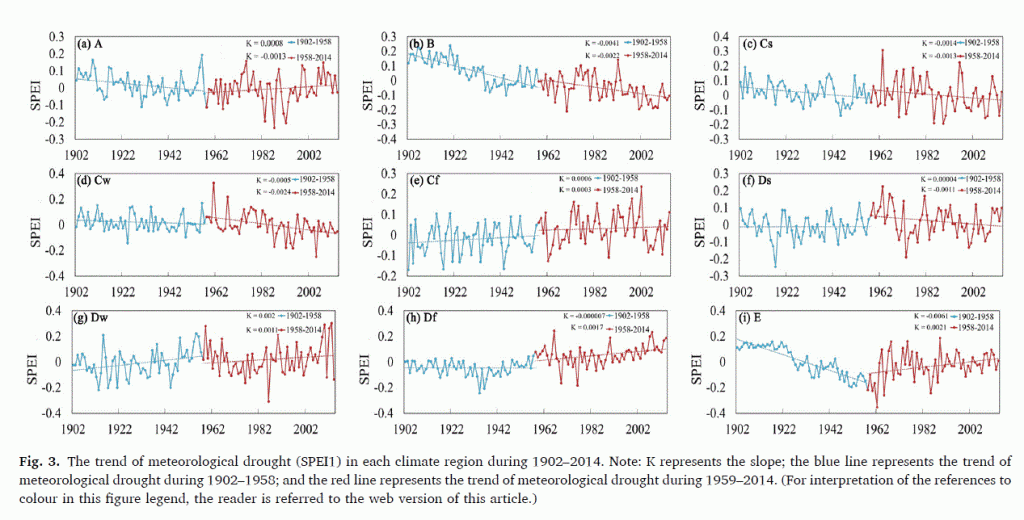 Meteorological Drought trends. (Click to Enlarge) Shi et al 2023 The second set of graphs are the hydrological drought trends (a lack of water supply): 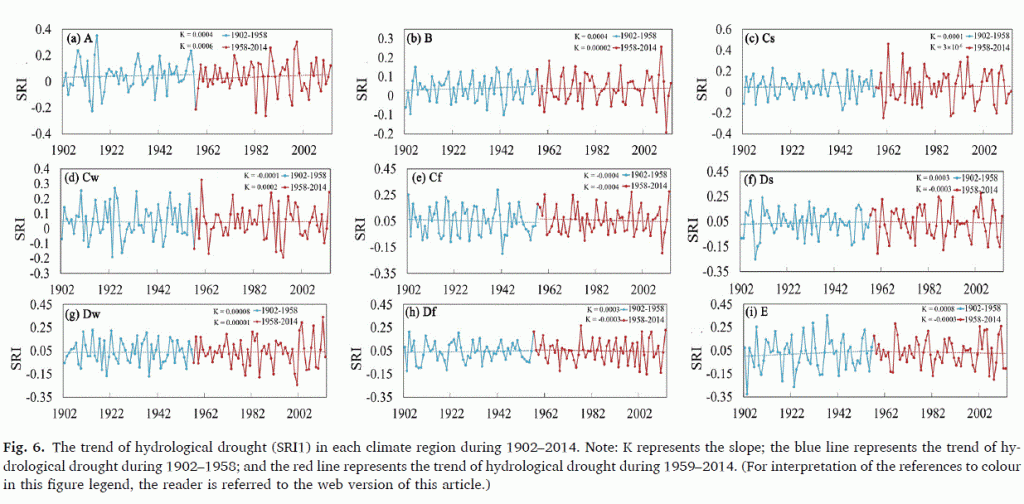 Hydrological Drought trends. (Click to Enlarge) Shi et al 2023 These are the climate zones the study used: 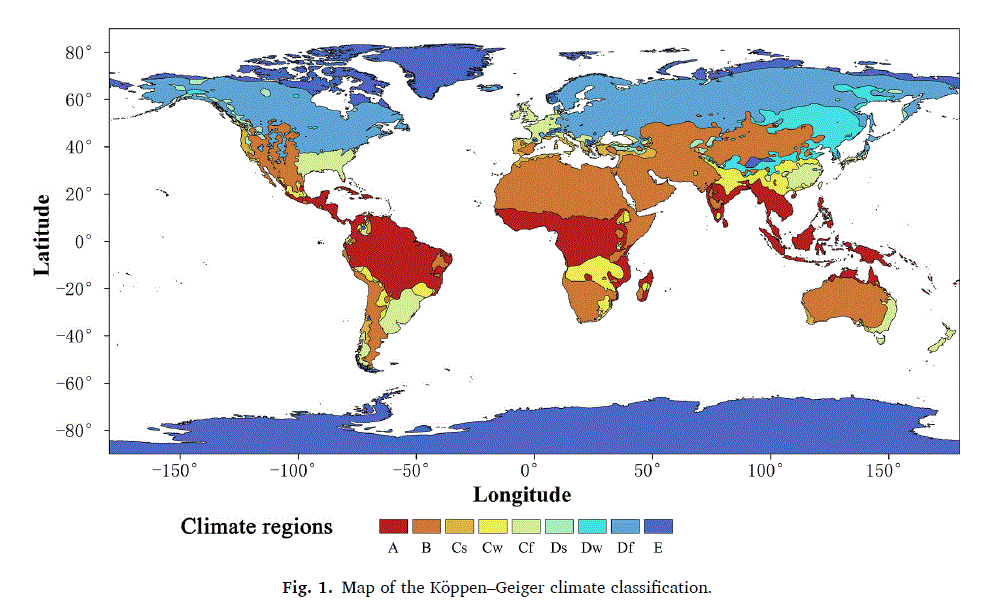 Classification of different drought regions of the world. Shi et al 2023 (Essentially Australia is B, Cf and A, The USA is B, Cf and Df. The UK, France, Germany and NZ are Cf). Even longer studies show that droughts and floods have always happenedFully 178 years of Australian rainfall showing no trend at all in relation to CO2. A study on one thousand years of rainfall in Antarctica suggests droughts and floods used to be longer, worse. Indeed, old world megadroughts in past 2000 years worse, longer, than current droughts. The deadliest droughts in India were before 1924…. etc. For more posts on these see the tags: Rain , Drought, Floods, Australian rainfall DEFINITIONSAccording to NOAA, a Meteorological Drought is a lack of rain suffered for an extended time, whereas a Hydrological Drought is a lack of water supply such as stream flow, reservoir and lake levels, and ground water. REFERENCEHaiyun Shi et al (2023) A global perspective on propagation from meteorological drought to hydrological drought during 1902–2014, Atmospheric Research
As David Maddison, Penguinite, MP, Andrew McRae, Konrad and others suggest: Don’t forget to put your submissions in opposing the latest proposed Australian Government censorship legislation. “New ACMA powers to combat misinformation and disinformation”. They don’t have to be long. But it closes on August 20th. Read Konrad’s submission here. The plan: The hapless homeowners will buy the back up battery for the grid and install it in their garage. Sometimes they might drive it too.
There are moves to make this happen in California, Australia and Europe. There have already been 170 trials around the world costing millions of dollars to try to figure out how to do this. Clearly it’s a big agenda. Repeated charges and discharges must shorten the life of the battery, and possibly inconvenience car owners too if they get caught without the fuel in the tank. What if there is family emergency at 11pm? (Well, you can catch a cab.) As well as this, every EV added to the grid is like adding “3 to 20 new houses“. Energy losses with batteries are around 20% and worse as the battery ages. Despite the downsides, network managers are excited at the thought of using the collected mass of EV batteries to stabilize the grid, and it’s being sold as “a great way to reduce your power bills”. Why electric car tech could drive down power pricesJennifer Dudley-Nicholson, The Driven A report from the Australian Renewable Energy Agency (ARENA) says the technology could become the nation’s biggest electricity storage opportunity in the next decade and has the potential to save consumers more than $6000 on the lifetime cost of charging an electric car. “Electric vehicles offer massive, untapped storage potential,” she says. “In 10 years, Australia’s electric car fleet is likely to have more battery capacity than Snowy 2.0 – that’s a whole lot of storage on wheels that is parked about 95 per cent of the time.” A bill has been introduced in California to require all EV’s to have “Bi-directional” charging by 2027. GM just announced it will be standard on one of the EV series by 2026. Tesla plans to have bidirectional charging by 2025, though Elon Musk is unimpressed and says it’s ‘inconvenient‘. South Australia is already running a trial where private electric-car owners can send their battery’s energy back into their own homes. Savings are listed “per decade” — it’s that bad: The greatest savings could be unlocked by drivers in South Australia and NSW, the report found, while those in Queensland and the ACT could access smaller discounts of more than $1000 over a decade. So that’s a big $100 a year discount for people in Queensland or the ACT for the more rapid devaluation of an asset that costs $60,000 to $100,000? It may shorten the life of the car by a year or two, and increase the risk of house fires, but otherwise it’s a “great idea”. This partly explains the push for mass forced uptake of EV’s — they are the big band-aid for unreliable renewable-grids. It’s obviously not about “saving us from climate change” because no one is even sure if EV’s will reduce emissions (and the emissions are beneficial anyway). What EV’s will enable (apart from tracking, spying, sabotage and remote control) is more stability on fragile grids burdened with too many wind and solar plants. But how does this make any sense when grids need to add generation to charge the EV’s? The Australian ARENA Report admits it isn’t cost effective even at the high prices of last year: The REVS trial used 51 Nissan Leaf cars in Canberra to examine the cost effectiveness of using car batteries to improve grid “energy stability”. But they concluded it wasn’t worth it yet, which was a shame because the trial itself cost $2.7 million. “Today, V2G has challenging economics. But in some niche use cases, where vehicles are plugged in for extended periods, V2G could soon be economic. In most cases charger prices still need to drop before V2G is economic.” Of course, if the corrupt management of the grid makes electricity prices expensive enough, sooner or later it will “make sense” to use your car as a grid stabilizer to save a few dollars. They just need to screw up the market some more to make EV-dis-charging “appealing”. As Stephen Green said imagine the government wanted to siphon your gas tank? You go to the gas station to top off your tank for a long road trip. Unbeknownst to you, the gas station is actually a little low on gas because the manager forgot to call Shell HQ and order a tanker truck for a refill. When you stick the gas pump in the side of your car, the intelligent pump notices that you’ve actually got more than half a tank. So instead of pumping gas into your car, the gas station siphons a gallon out of it. Just to stabilize the station’s supply, don’t you know? Depending on how much control householders have of their “smart” charger, and how aggressive governments are with “incentives” it’s a fair question to ask, “who owns the battery”? Like rooftop solar panels and air conditioners controlled by government agencies, more of what we thought we owned is really just rented from “the State”. You will own nothing… EV charging image by Nerijus jakimavičius
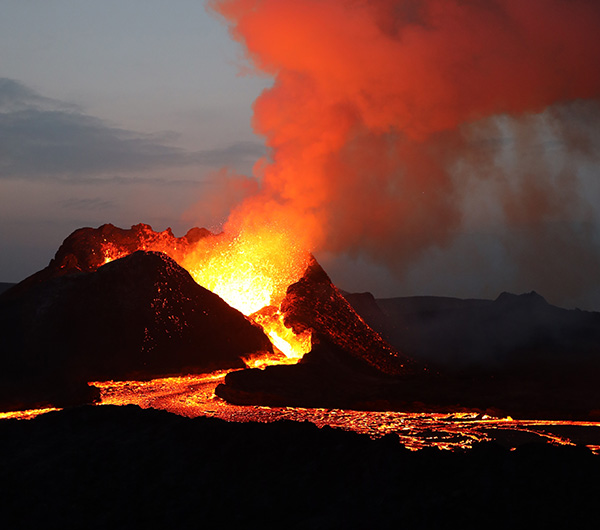 Photo by Toby Elliott on Unsplash We need to know: Can We Stop Volcanoes with Solar Panels?Quick set up a summit. Give me a grant. Climate Change causes more rain (except when it causes more drought), and apparently the weight of “up to” four meters of monsoon rainfall can compress a crustal plate leading to earthquakes. Now, four meters of rain means a lot to a pitiful 1.8 meter homo sapiens, but it’s hard to believe a plate of rock 30 kilometers thick would care less or even notice. It’s all absurd. The whole article, written by a “Reader in Physical Geography” at Coventry Uni makes out the climate change is all around us, but unwittingly depends on the idea that the Sun is just a big torch shining on Earth, and not a raging nuclear magnetic dynamo 300,000 times bigger than the planet, blasting us with charged particles at a million miles an hour and with a magnetic field that stretches past Pluto. Poor Dr Blackett with his 20 years of university education was never taught about the Sun. He has a pretty graph pointing out some correlation between earthquakes and monsoons but doesn’t once ask if The Sun might be causing both. What’s more likely, that changes in the solar magnetic field destabilize tectonic plates or your SUV does? And we don’t even need to guess, it’s already very well established that solar cycles are linked to rainfall, jetstreams, floods, and groundwater, even unpaid bloggers know this. If only universities had not devolved into propaganda houses where people can write abject drivel and there’s not a single well trained person left to point it out. It’s cruel, except he’s paid well to write this. He probably thinks he’s being provocative, but he’s just proving what a wasteland Big Government Science is: How climate change might trigger more earthquakes and volcanic eruptionsMatthew Blackett, The Conversation A warmer atmosphere can retain more water vapour, subsequently leading to higher levels of precipitation. Interestingly, geologists have long identified a relationship between rainfall rates and seismic activity. In the Himalayas, for example, the frequency of earthquakes is influenced by the annual rainfall cycle of the summer monsoon season. Research reveals that 48% of Himalayan earthquakes strike during the drier pre-monsoon months of March, April and May, while just 16% occur in the monsoon season. During the summer monsoon season, the weight of up to 4 metres of rainfall compresses the crust both vertically and horizontally, stabilising it. When this water disappears in the winter, the effective “rebound” destabilises the region and increases the number of earthquakes that occur. It’s like reading tea-leaves: He’s worried that climate change might melt glaciers and cause decompression melting to occur in the mantle leading to volcanoes. But he’s reassured “phew” because there was a lag of several hundred years… It’s a cult. Read the few comments left at The Conversion site where people like us are theoretically banned. “We are truly too late to do anything that will prevent this disaster.” |
||||
|
Copyright © 2024 JoNova - All Rights Reserved |
||||

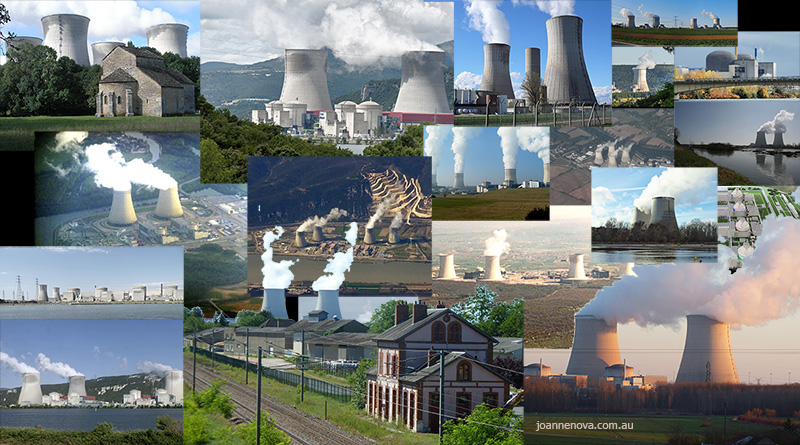



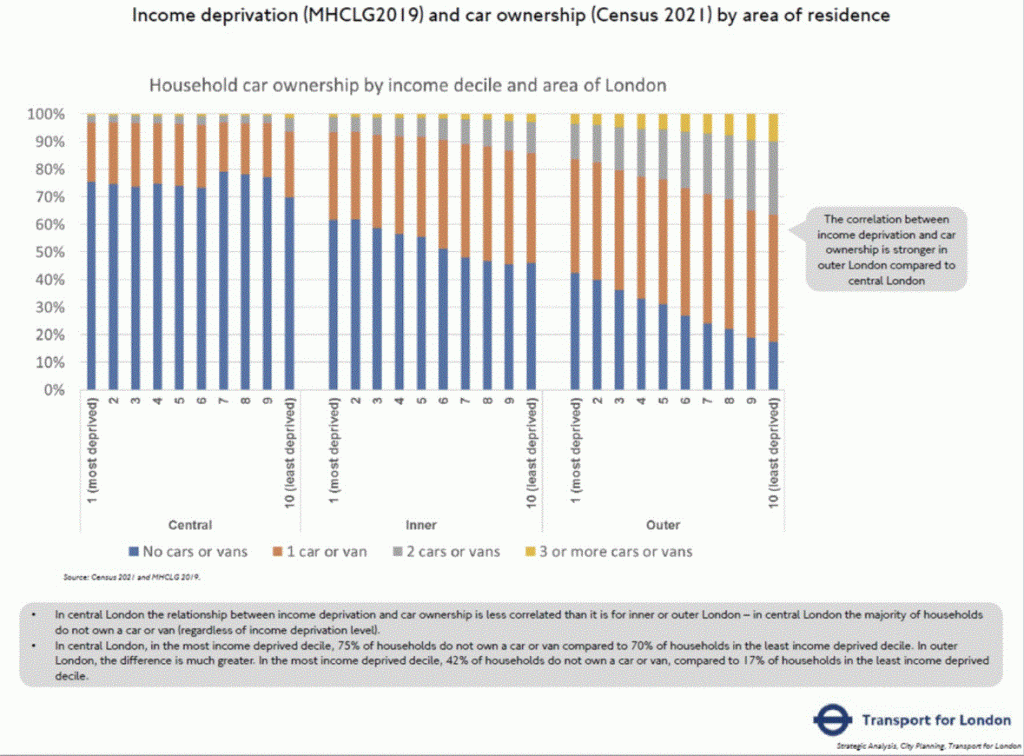

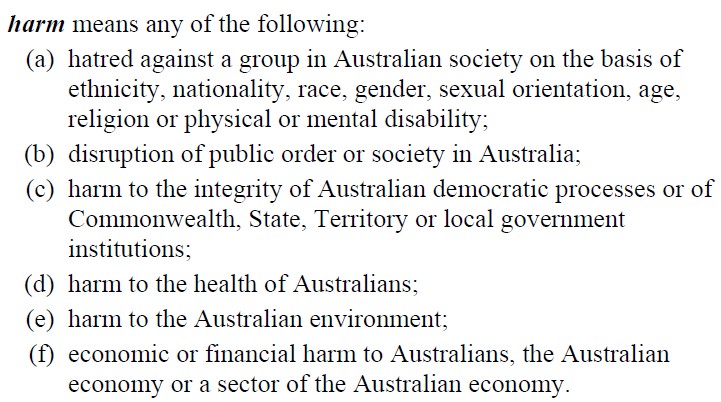


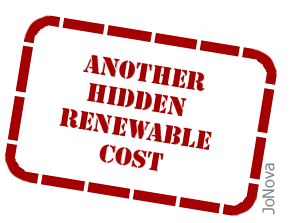
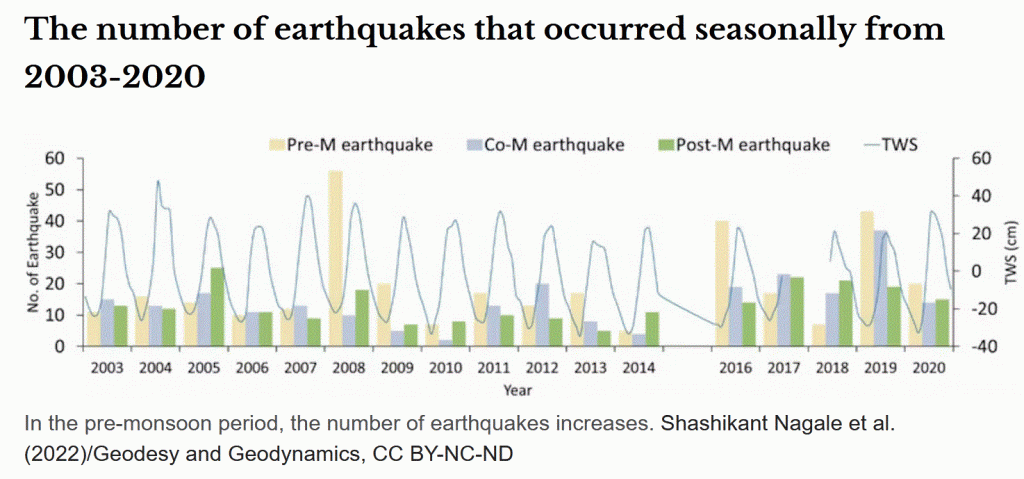











Recent Comments